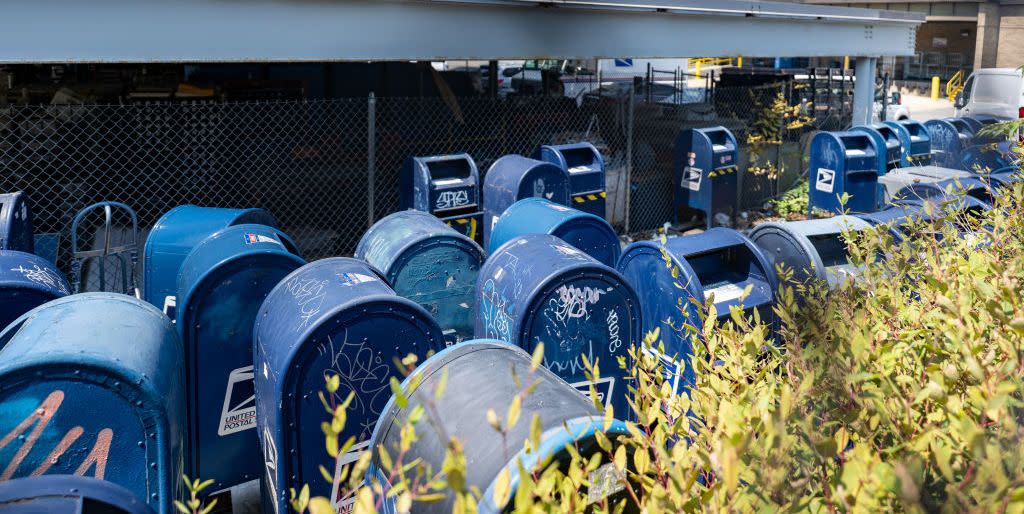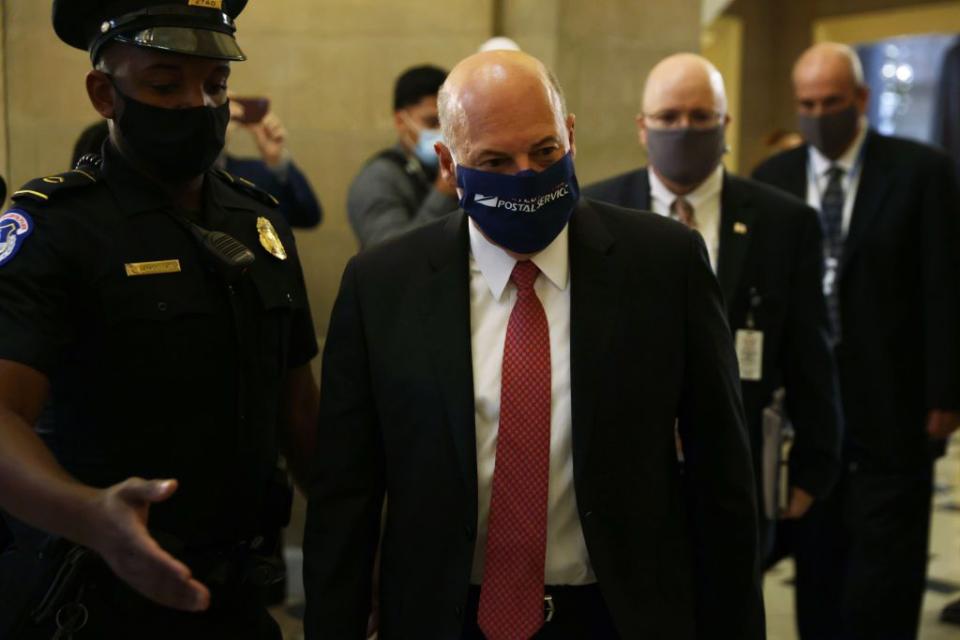How to Save the USPS, Because That's a Thing We Have to Do Now

If you had "Disappearing Mailboxes" on your Things We're Worrying About in 2020 bingo card, please come forward to collect your prize. In a year filled with a global pandemic and a painful national reckoning on racial inequality, the vanishing vessels are top of mind after a record number of people voted from home via absentee ballots. Mere months away from the next presidential election, President Donald Trump has launched a war on the United States Postal Service. His attack coincides with the USPS's nearly $9 billion loss amid challenges to meet mailing demands during the COVID-19 pandemic.
Ahead, everything we know about the mailing situation and how you can help the USPS in its time of need.
Trump has said he will cut funding for the USPS.
Last week, Trump appeared on Fox Business, where he confirmed his intention to cut $25 billion in funding proposed as part of a coronavirus stimulus package. The plan has been halted in Congress after Democrats proposed $3.6 billion in aid for elections in November. “They need that money in order to have the post office work so it can take all of these millions and millions of ballots,” Trump told Fox Business’s Maria Bartiromo, via The Guardian. “If they don’t get those two items, that means you can’t have universal mail-in voting because they’re not equipped to have it.”
Trump just openly admitted during an interview on Fox Business that he is holding up aid to the post office to stop mail-in ballots. “They need that money in order to make the post office work so it can take all of these millions and millions of ballots..."
— Ellie Rushing (@EllieRushing) August 13, 2020
Trump has blamed mail-in ballots for voter fraud, despite requesting one himself.
The legitimacy of mail-in voting or absentee ballots has been called into question by Trump, despite the fact that he himself requested a mail-in ballot for Florida’s primary election. But his comments have inspired both confusion and criticism, as he seems to support "absentee voting," while critiquing "mail-in voting," although those practices are essentially the same, CNN points out.
"Mail-In Ballot fraud found in many elections," he recently tweeted, although mail-in voting doesn't carry any substantial fraud rate. "People are just now seeing how bad, dishonest and slow it is. Election results could be delayed for months. No more big election night answers? 1% not even counted in 2016. Ridiculous! Just a formula for RIGGING an Election. Absentee Ballots are fine because you have to go through a precise process to get your voting privilege. Not so with Mail-Ins. Rigged Election!!! 20% fraudulent ballots?"
"No-excuse mail voting or absentee voting—whatever you call it—is essentially the same thing," David Becker, founder of the nonpartisan Center for Election Innovation and Research, told CNN. "You request a ballot, you get a ballot, you vote, you send it in, and there are protections in place. It doesn't matter whether you call it mail voting or absentee voting. It's the same thing." The outlet also reported that several in Trump's administration have voted by mail, including Vice President Mike Pence, White House press secretary Kayleigh McEnany, White House counselor Kellyanne Conway, and Trump family members "who tried to vote absentee but sent the ballots in too late," according to CNN.
Trump also shifted USPS leadership and appointed a new Postmaster General.
As is customary with Trump's administration, there have been some personnel changes in relation to the postal service. According to the Washington Post, Trump has "reassigned or displaced" at least 23 USPS executives and enforced a hiring freeze within the service. In May, Trump appointed Postmaster General Louis DeJoy, a North Carolina businessman and Trump donor who has invested millions in companies that compete with the USPS, reports indicate. DeJoy is also the first postmaster general in almost two decades who was not a postal employee prior to his appointment, per the New York Times.

Since his appointment, DeJoy has taken extreme measures to cut costs within the organization. Those include canceling employee overtime, taking mail-sorting machines from postal locations in the U.S., and implementing a rule that mail is kept until the next day if distribution centers are behind schedule, the Times reports. All of these changes have sowed doubt about the USPS's ability to handle an influx of absentee ballots come November.
Mailboxes have been disappearing across the country.
Trump's budgetary war with the postal service became very real when photos of mailboxes being removed in Oregon, New York, and Portland began to emerge. Soon after the pictures of blue mailboxes stacked together in trucks went viral, the USPS made a statement. “For decades, the installation and removal of the Postal Service’s iconic blue collection mail boxes from streets across the country has been based on mail volume received in those boxes,” a USPS representative told NBC. “It is a fluid process and figures can vary from day-to-day. Historically, mail boxes have been removed for lack of use and installed in growth areas.”
Good morning Manhattan pic.twitter.com/mXUF45IBfC
— Azi™ (@Azi) August 14, 2020
Eugene, Oregon:
Mail Boxes being removed pic.twitter.com/W3E1LreqOa— Susie Greer (@VtSusie) August 13, 2020
Warren, Ohio this morning. The sun isn’t even up good & they’re still snatching mailboxes 😡 pic.twitter.com/CXWUxmfHn3
— JackluvsU (@JackluvsU) August 16, 2020
A second USPS spokesperson told KOIN 6 that mailboxes in Portland had been damaged and were being replaced “with newer, more secure models,” but that “every location that had a collection box will keep a collection box.” Kim Frum, USPS senior public relations representative, told The Cut that “for decades” collection boxes had been removed “based on mail volume received in those boxes.” She offered, “When a collection box consistently receives very small amounts of mail for months on end, it costs the Postal Service money in fuel and work hours for letter carriers to drive to the mailbox and collect the mail.” Removed boxes would then usually be reassigned to “growth areas,” or “high traffic areas such as shopping centers, business parks, grocery stores, etc., for increased customer convenience.”
The USPS is essential for several underserved or marginalized groups.
For those wondering why a dismantling of the postal service is a problem, the organization is vital to many marginalized areas. Vox reported that rural America, tribal lands, and those in low-income areas are served by the USPS in lieu of broadband or access to delivery options, including UPS and FedEx.
But, according to How the Post Office Created America author Winifred Gallagher, the fight against the USPS isn't new territory:
"I would date the current crisis to the 1980s, when a very timid USPS management and Congress fatefully decided not to shift from letter mail to email," Gallagher said on NPR's Weekend Edition. "They could have given Americans digital addresses the same way they gave us our physical street addresses. And in fact, of course, as everyone knows, by 2001, email had drastically reduced the volume of first class letter mail, and then that crisis was worsened further by the really disastrous Postal Accountability and Enhancement Act of 2006, which restricted the Postal Service's ability to offer new services or adjust its pricing to its cost and, worse, required it to prefund its retiree health care benefits decades into the future, which created billions of dollars of debt. And that is what has prevented the post office from turning a profit for the past six years."
Here's how you can help.
Faced with concerted attacks on the postal service and its implications for voting in November, here are ways you can aid the USPS.
Request a ballot and vote early.
When Taylor Swift gets involved, you know the situation is dire. As the singer tweeted over the weekend, "Request a ballot early. Vote early." Checking your state's election deadlines is vital to having your voice heard prior to November 3. With delivery dates set to be delayed, requesting a ballot and voting early will combat scheduling issues.
Check your state's voting deadline
Buy stamps—or a crop top.
To financially support the USPS, consider buying stamps or a piece of merch from the organization's site. The New York Times outlined a few of the items for sale on its online store, including a mail carrier dog costume, tote bags, and a now sold-out crop top with the service's logo. Buy a mug, save a nearly 50-year-old institution?
Call your representatives.
Locate your representatives and contact them in any way you can, be it a call, Instagram DM, or tweet. Prior to reaching out, educate yourself about your state's policies surrounding absentee ballots or mail-in voting. You can request an extension for voting deadlines or increase in collection boxes for your local area.
Sign a petition.
Several petitions have circulated for spreading the word about USPS's ongoing plight.
• Sign this Change.org petition or this "Save the USPS" Change.org petition.
• Sign this MoveOn petition to "Fully Fund the U.S. Postal Service" or this MoveOn petition to "Tell Congress to Save Our Postal Service."
• Sign this Common Cause petition to "Save the U.S. Postal Service"
• Sign this Center for American Progress petition.
• Sign this White House petition to "Save the United States Postal Service."
Volunteer or donate to organizations combatting voter suppression.
A direct way to help in the fight against voter suppression is to volunteer to be a poll worker on election day. You can also support a number of organizations committed to ending voter suppression, courtesy of the American Bar Association and The Cut. Those mentioned by the mentioned outlets, and a few others to consider, include:
ACLU, Asian Americans Advancing Justice, Brennan Center for Justice, Common Cause, Election Protection, Fair Fight, Indivisible, League of Women Voters, Let America Vote, More Than a Vote, Movement Voter Project, NAACP, National Voter Protection Action Fund, Spread the Vote, Voto Latino, VoteRiders, and When We All Vote.
You Might Also Like

